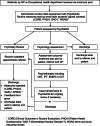Taking care of our future doctors: a service evaluation of a medical student mental health service
- PMID: 32471406
- PMCID: PMC7257172
- DOI: 10.1186/s12909-020-02075-8
Taking care of our future doctors: a service evaluation of a medical student mental health service
Abstract
Background: Studies suggest medical students experience high levels of mental distress during training but are less likely, than other students, to access care due to stigma and concerns regarding career progression. In response, The School of Clinical Medicine, University of Cambridge supported the development of the 'Clinical Student Mental Health Service' to provide specialist input for this vulnerable group. This study evaluates the efficiency and effectiveness of this service.
Methods: Using mixed-methods, cross-sectional analysis of validated psychiatric rating scales and qualitative feedback, 89 responses were analysed from 143 clinical students referred, between 2015 and 2019. The care pathway included initial review by a psychiatrist, who triaged students to psychologists delivering therapies including: Cognitive Behavioural Therapy, Interpersonal Therapy, Eye Movement Desensitization Reprocessing Therapy or Cognitive Analytic Therapy. Efficiency was assessed by waiting times for psychiatry and psychology interventions, and number of sessions. Academic outcomes included school intermission and graduation. Clinical effectiveness was analysed by measuring global distress, depression, anxiety, functioning and suicidal risk. Pre/post intervention changes were captured using t-test and McNemar test with thematic analysis of qualitative feedback.
Results: Referral rates increased from 3.93% (22/560) in 2015 to 6.74% (45/668) in 2018. Median waiting times for initial psychiatric assessment and start of therapy was 26 and 33 days, respectively. All graduating students moved on to work as junior doctors. Levels of distress, (t = 7.73, p < 0.001, df = 31), depression (t = 7.26, p < 0.001, df = 34) anxiety (Z = - 4.63, p < 0.001) and suicide risk (Z = - 3.89, p < 0.001) were significantly reduced. Participant's functioning was significantly improved (p < 0.001, 99.5% CI 4.55 to 14.62). Feedback indicated high satisfaction with the rapid access and flexibility of the service and the team clinicians.
Conclusions: A significant proportion of medical students attending the service scored highly on validated rating scales measuring emotional distress, suicidality and mental illness. Reassuringly they benefitted from timely specialist mental health input, showing improvements in mental well-being and improved functioning. The development and design of this service might serve as an exemplar for medical schools developing similar support for their students.
Keywords: Fitness to practice; Higher education; Medical Student; Mental disorders; Service evaluation.
Conflict of interest statement
All authors have completed the ICMJE uniform disclosure form at
Figures
References
-
- Macaskill Ann. The mental health of university students in the United Kingdom. British Journal of Guidance & Counselling. 2013;41(4):426–441.
-
- Regehr Cheryl, Glancy Dylan, Pitts Annabel. Interventions to reduce stress in university students: A review and meta-analysis. Journal of Affective Disorders. 2013;148(1):1–11. - PubMed
-
- MacLean Lisa, Booza Jason, Balon Richard. The Impact of Medical School on Student Mental Health. Academic Psychiatry. 2015;40(1):89–91. - PubMed
-
- Dyrbye Liselotte N., Thomas Matthew R., Massie F. Stanford, Power David V, Eacker Anne, Harper William, Durning Steven, Moutier Christine, Szydlo Daniel W., Novotny Paul J., Sloan Jeff A., Shanafelt Tait D. Burnout and Suicidal Ideation among U.S. Medical Students. Annals of Internal Medicine. 2008;149(5):334. - PubMed
-
- Dahlin M, Joneborg N, Runeson B. Stress and depression among medical students: a cross-sectional study. Med Educ. 2005;39: 594-604. Available from: doi:10.1111/j.1365-2929.2005.02176.%20x. - PubMed
MeSH terms
LinkOut - more resources
Full Text Sources
Medical
Miscellaneous


